
The FM/FE series was my first contact with the Nikon F-Mount (that was in 1979). No doubt, FM and FE were and still are great cameras. But their look was a usual one of that time: for instance, a Canon FT-b, Leica R3, Minolta XE-7, Pentax MX or Praktica EE2 look overall very similar.
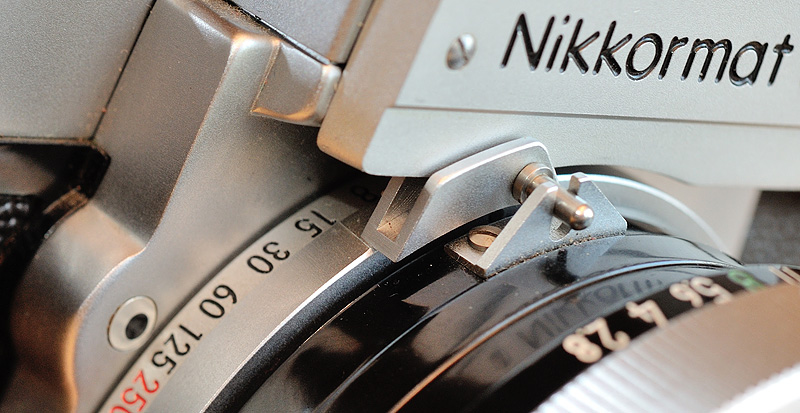
|
In contrast, the older Nikon cameras I saw in the "used" section of photo shop windows appeared really exotic to me. I remember a couple of silver samples of the Nikon/Nikkor F with their impressive Photomic finders. Then there were a lot of Nikon cameras with a funny name: Nikkormat. Where a "normal" camera has its shutter speed dial, the Nikkormat has an impressive bull's eye covering the frame counter. Although the F2 Photomic still was Nikon's top model by the end of the 70s, the DP-2 finder appeared extraordinary to me. Moreover, all of these cameras share an exotic detail: the aperture coupling via a pin on the camera side and a coupling shoe on the lens side. By the end of the 70s a lot of professionals where still working with such older cameras. It was interesting to observe them, especially when they changed lenses. After mounting the new lens they made a fast forth and back rotation with the aperture ring - the so called semi-automatic aperture indexing. Even years later I saw professionals with F3 cameras doing the same movement...
The early years where also wild from a collector's point of view. This is especially true for the F: for example there are versions with a red dot somewhere, two samples with white leather are reported and the "Apollo version" (meaning the winding lever is plastic-covered) excites the collectors' community. I am not really interested in such cosmetic details and this article does not deal with these things.
This article is about the evolution of the meter coupling interface in the early years, that is the period between the launch of the F (and the F-Mount) in 1959 and the AI introduction in 1977. Of course, this is history and not really of interest for today's photography. On the other hand, feeling the exoticism of these years by yourself it is a relatively cheap thing today. I'll give you a recommendation for a first step at the end of this article.
The F and F2 themselves are mechanical cameras without metering! These professional cameras have changeable finders. You can get eye-level, waist-level, magnification and action finders. Moreover, starting in 1962 Nikon offered the "photomic finders", a combination of an eye-level finder and an exposure meter that makes an F or F2 a camera with metering. But even in the 70s some photographers - especially professionals - preferred the much smaller non-metering eye-level finders.
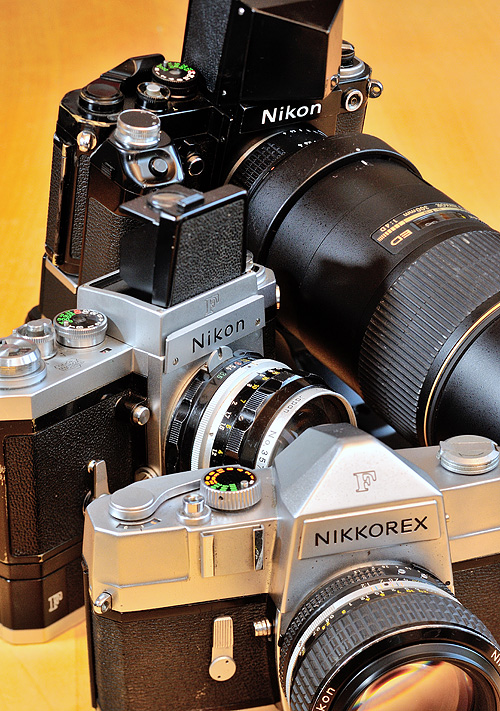
|
|
Non-metered bodies Nikkorex F with Nikkor 50mm f/1.2 AIS, Nikon F with waist-level finder and Nikkor-H 2.8cm f/3.5 and Nikon F2 with action finder and AF-S Nikkor 300mm f/4. |
In 1962 Nippon Kogaku (former name of the Nikon Corporation) introduced the Nikkorex F (in Japan Nikkor J). It was a non-metering camera targeting the amateur market. This camera was produced by Mamiya by order of Nippon Kogaku. The Nikkorex was superseded by the Nikkormat (in Japan Nikomat), that was introduced in 1965 in a double pack: Nikkormat FT with TTL metering and Nikkormat FS without any metering. These cameras were developed and produced by Nippon Kogaku. The FS was not very successful (in contrast to the FT) - the production was stopped after two years. Today the very few Nikkormat FS bodies get dusty on several collector shelfs and are hard to find on the used market.
The only coupling element of a non-metered body is the aperture lever that holds the aperture wide open while you are looking through the finder and that stops down the lens just after the shutter release button has been pressed. In the 60s a camera with such a feature was often called an "automatic SLR", because it was an important improvement in terms of focussing over many older SLRs. BTW, the first SLR with such an automatic aperture control (but without an instant-return mirror) was the screw-mount Praktica FX2 from 1956.
Except for Nikon's newest lenses ('G' or 'E' type) nearly every Nikon F-Mount lens is usable in conjunction with the non-metered cameras.
Many names are in use for the small forks mounted on the aperture rings of older Nikkor lenses. In this article I name them shoes or coupling shoes. These shoes were essential for the meter coupling between the camera and the lens during the early years.
At the beginning the shoes were triangle-shaped. Later, semicircle-shaped shoes were mounted. No big difference, but the latter ones were a bit more reliable in conjunction with the photomic finders. Even after the AI introduction Nikon mounted coupling shoes on their lenses. Every AI Nikkor and nearly every AI-S Nikkor got one. These newer AI-type shoes are also semicircle-shaped, but they have two additional holes for getting more light on the ADR scale (ADR = aperture direct readout). Many people removed the shoes of their AI-modified, AI or AI-S lenses after they had completely switched to AI cameras. Therefore such lenses are often offered without a shoe on the used market.
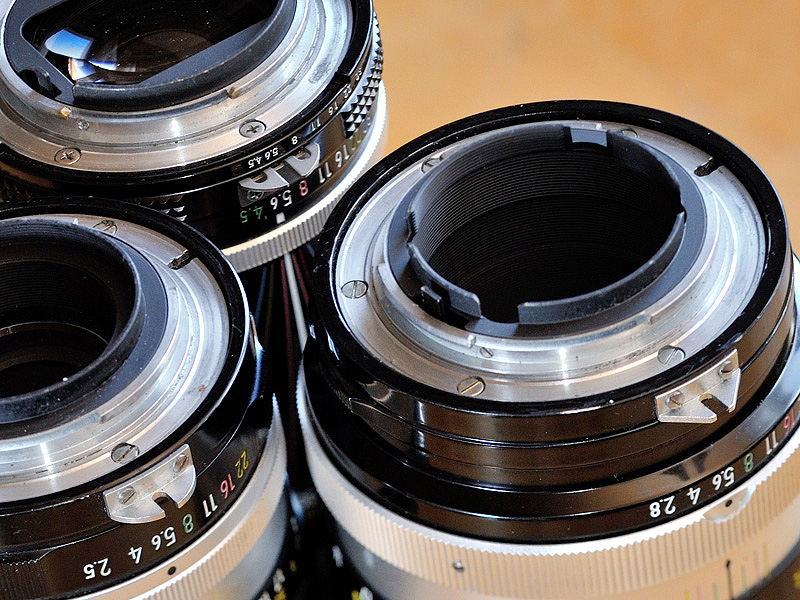
|
|
In the foreground the two types of coupling shoes in the early years. In the background an AI lens with the typical coupling shoe of AI and AI-S lenses. |
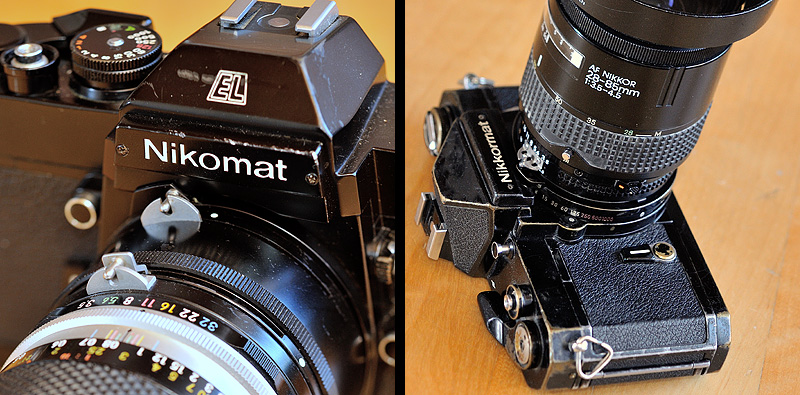
|
|
In the 70s Nikon introduced coupled automatic tubes and teleconverters. On the left an PK-3 tube (predecessor of the PK-13) between the Nikomat EL and a Micro-Nikkor 55mm f/3.5. AF lenses (with an aperture ring) came without a coupling shoe. But it is possible to mount one. On the right my DIY retrofitted AF Nikkor 28-85mm f/3.5-4.5 on a Nikkormat FT2. |
AF lenses were delivered without a coupling shoe. But nearly every AF lens with an aperture ring has marks for one or both screws of a shoe. Thus, I guess the Nikon service is able to mount a coupling shoe onto your AF lens. Have a look at my links section under "lens conversion services", too! Of course, DIY is also possible. I tried it with an AF Nikkor 28-85mm (using an AI shoe). I bored small holes at the marked points, smaller in diameter than the screws, because the screws must cut their own thread. I did not remove the aperture ring for that. Every AF nikkor I know has an aperture ring made of plastic. That makes the boring and screwing overall simple.
This evolution consists of three phases:
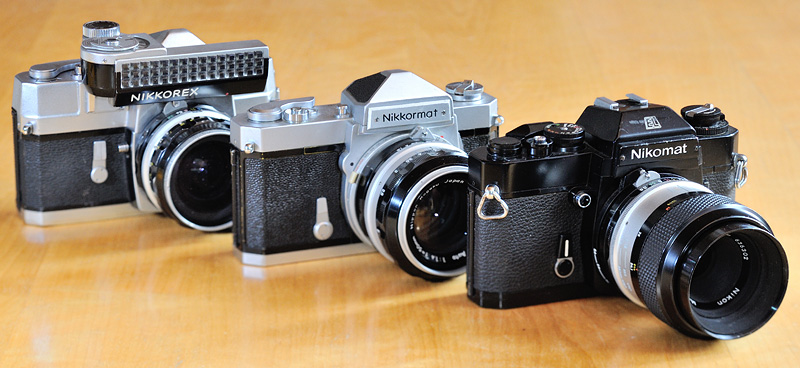
|
|
The interface evolution of the consumer models Nikkorex F with external meter, representing the coupled external metering phase. Nikkormat FT, representing the early TTL phase. Nikomat EL, representing the later TTL phase. |

|
|
The interface evolution of the professional models took place solely in the finders From left to right: Non-metered prism finder with the coupled external meter. The first Photomic finder, another example of the coupled external metering phase. Photomic TN finder, representing the early TTL phase. Photomic FTN finder, representing the later TTL phase. |
Together with the Nikon F Nippon Kogaku introduced a mountable meter as an accessory. It is coupled with both the lens coupling shoe and the shutter speed dial as well. The coupling between lens and meter must be done by rotating the aperture ring so that the coupling shoe moves along the pin. Due to a spring mechanism the pin automatically flips into the shoe. A nearly identical accessory was introduced in 1962 to work in conjunction with the Nikkorex F. These meters work with selenium photo cells, thus they don't need batteries.
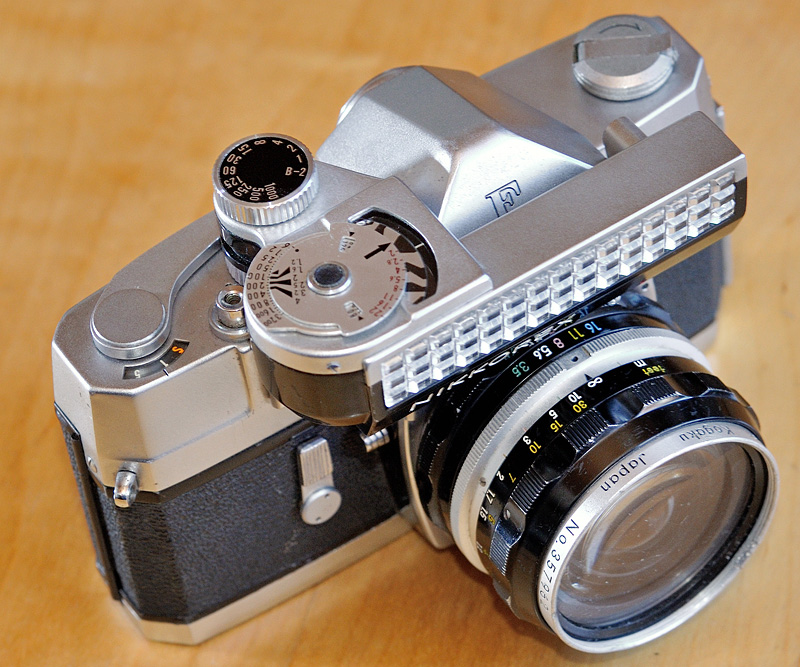
|
|
Nikkorex F with external meter. By rotating the shutter speed dial the black arrow moves - rotating the aperture ring moves the white needle. If needle and arrow match the exposure should be perfect. |
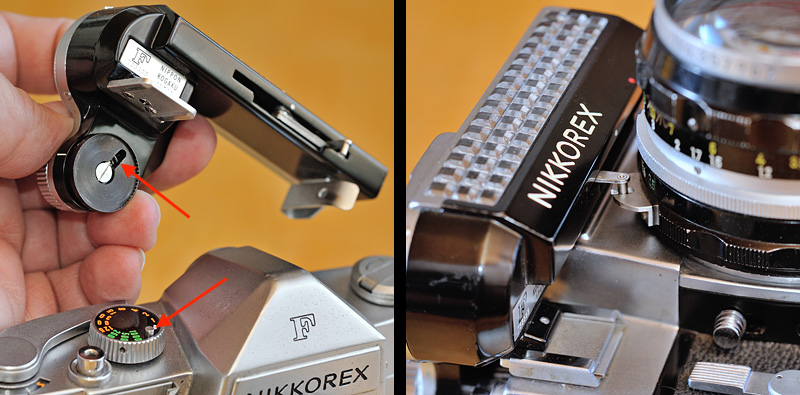
|
|
The external meter is coupled with the shutter speed dial of the camera and with the coupling shoe of the lens as well. |
A huge step forward in terms of ergonomics was the first Photomic finder for the Nikon F. The measuring is made by CDS cells and therefore the Photomic needs a battery. On the other hand a CDS cell is more sensitive than a selenium photo cell. You have to center a needle by rotating the shutter speed dial or the aperture ring. The needle is shown on the top of the finder and above the viewfinder image as well.
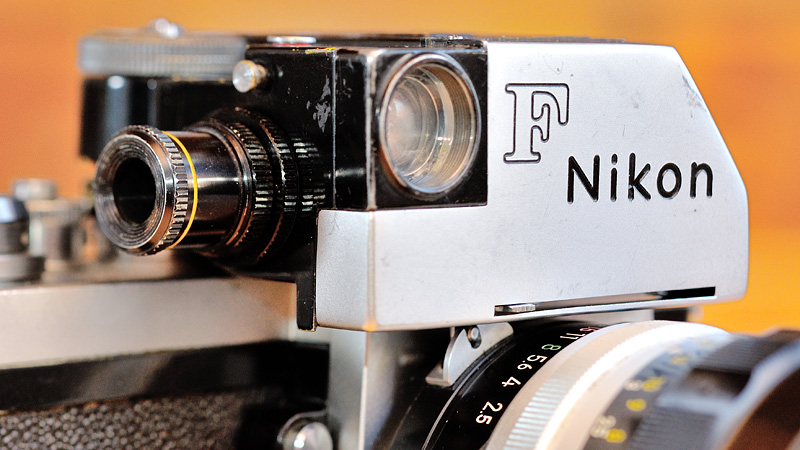
|
|
50-year-old hightech: the first Photomic finder for the Nikon F. There is a screw mount for accessories around the CDS cell. A tube for narrowing the angle of measure (if you work with telephoto lenses) and a special white translucent filter for doing incident light measurement belong to the finder. As shown here, these accessories can be screwed into to a second mount in the cap of the battery compartment on the side of the finder, if they are not needed. |
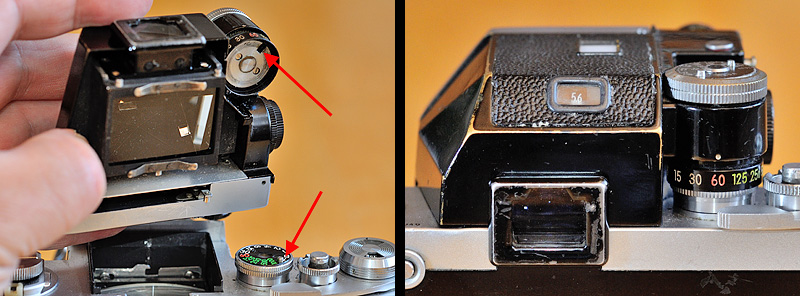
|
|
Every Photomic finder is coupled to the shutter speed dial in the same way. Nice detail for its time: shutter speed and aperture are shown close to the eyepiece. |
The Nikkor lenses were designed to submit the absolute aperture value to the camera. Exactly that is needed for coupled external metering. Thus, everything was still in order in that era...
In 1964 Asahi Optical launched the Pentax Spotmatic as the first SLR with Through-The-Lens metering. Although the lens had to be stopped down for metering and despite the fact that it was a screw-mount SLR, the Spotmatic was a successful camera.
Nippon Kogaku introduced TTL metering in 1965 in the form of the "Photomic T" finder for the Nikon F and in the form of the Nikkormat FT. Both cameras allow open-aperture metering, which was great in that time. Nevertheless the TTL metering caused an interface problem for Nippon Kogaku. Because the metering goes through the lens the meter must know the speed of the lens for indexing. Thus, it would have been much better if the lens would transmit a relative aperture value instead of an absolute one. Nikon's first solution for this problem was the fully manual indexing. The ASA Dial of a Nikkormat FT and the Photomic T finder has a second scale with lens speed engravings - you have to move the dial such that the ASA value of the film matches the speed of the lens. Drawback: that must be done each time when the lens is changed (unless your lens line consists of lenses with the same speed). Today, we are familar with the digital version of this procedure: we have to enter the data of our non-CPU lenses into our DSLRs ;)
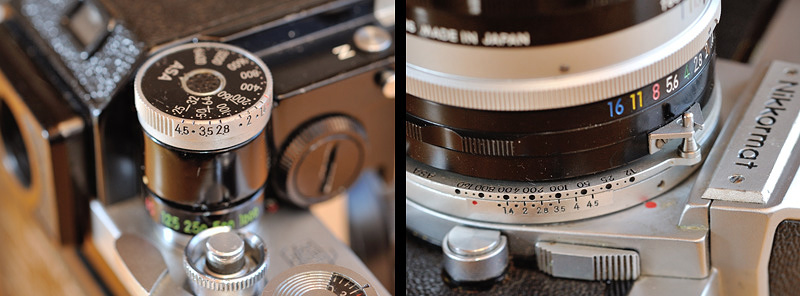
|
|
Fully manual indexing Nikon F Photomic TN, loaded with ISO 64 film and with an f/3.5 lens mounted, and a Nikkormat FT with ISO 400 film and an f/1.4 lens. |
|
|
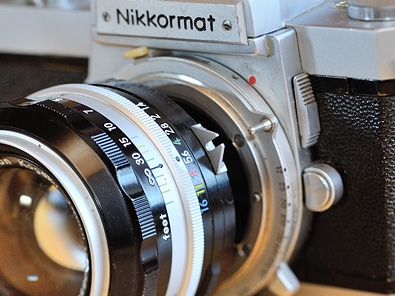
|
|
A handling drawback of every Nikkormat with a coupling pin: for mounting the lens the coupling pin must be at its rightmost position and the lens must be set to F5.6. |
The lens change itself is easy with a Nikon F Photomic T. The finder has the same spring mechanism like the older version with external metering and like the former external meters. With the Nikkormat FT the matching of pin and shoe must be done manually: before mounting the lens you must rotate the pin of the camera body to the outmost position and set the lens to an aperture value of F5.6. Then you can carefully mount the lens while keeping an eye on the proper connection of pin and shoe. This drawback is common with every Nikkormat until 1977.
In 1967 Nippon Kogaku replaced the Photomic T finder with the Photomic TN finder. The key improvement was the 60/40 centre-weighted metering. In terms of the interface nothing's changed.
A new coupling technology was introduced in 1967: The Nikkormat FTn - the successor of the FT - was the first Nikon with semi-automatic indexing. After mounting the lens, at first the lens must be stopped down further than F5.6 (for being sure I recommend to set the aperture ring to the smallest aperture meaning greatest F-number) and then the aperture ring must be rotated in the opposite direction to the smallest F-number. Now the unit is ready to use - the successful indexing can be checked on a small scale near the lens mount of the Nikkormat FTn. Exactly the same principle can be found in the Nikkormat FT2 (1975), EL (1972) and ELW (1976).
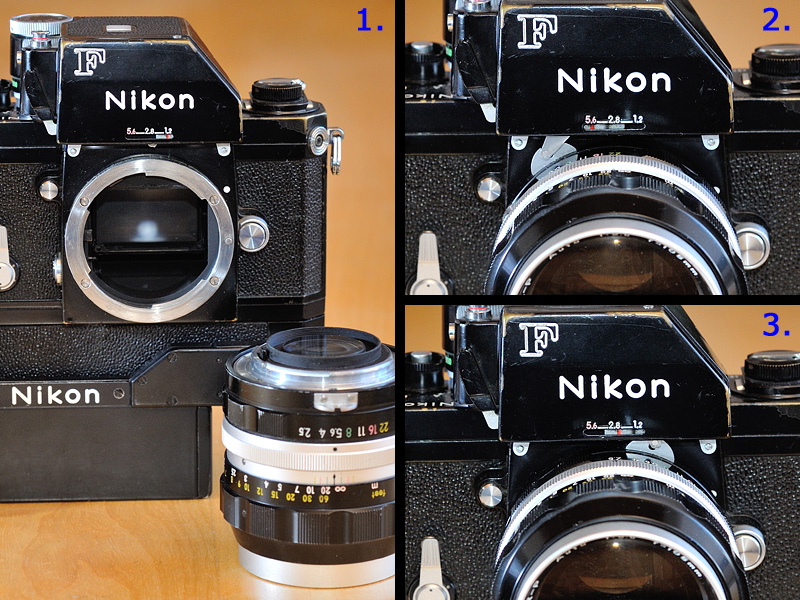
|
|
Semi-automatic indexing - lens mounting procedure 1. The Nikon F Photomic FTN before mounting an f/2.5 lens. Please note: the lens' aperture setting doesn't matter for the F and F2 series. 2. After mounting the lens the aperture ring should be rotated to the greatest aperture number. 3. Then is must be rotated to the opposite end. That's it - the red dot in the indexing scale shows F2.5, thus the indexing was successful. |
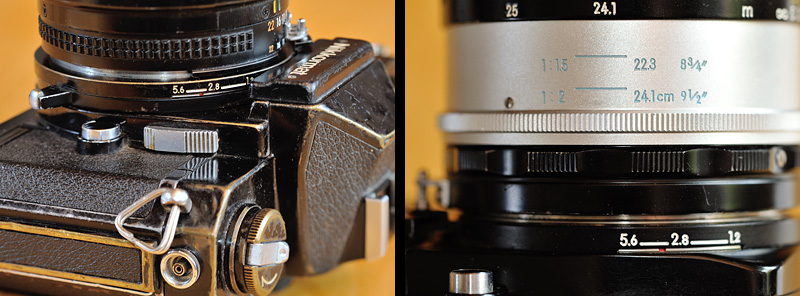
|
|
On Nikkormats the scale for checking proper indexing is located near the bayonet mount. The FTn and FT2 have the scale on the right side (shown on the left an FT2 with an f/3.5 lens) while the EL and ELW have it on the left side (shown here an EL with an f/3.5 lens). |
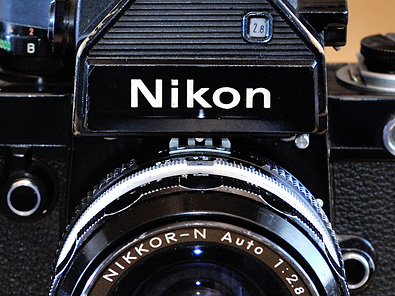
|
|
The Photomic finders for the F2 (shown here a DP-2) have a small window instead of a scale for checking successful indexing. |
In 1968 semi-automatic indexing became available for the Nikon F as well when Nippon Kogaku replaced the Photomic TN with the Photomic FTN finder. The FTN finder is the most advanced finder for the F. Like with its predecessors it is not necessary to set the lens to F5.6 before mounting.
The Photomic finders DP-1 (1971), DP-2 (1973) and DP-3 (1976) for the F2 inherited the interface from the FTN finder. There is only a cosmetic difference: the indexing scale of the FTN finder was replaced by a small window that displays the lens speed.
Please note: an F2 with a DP-2 finder is called F2S and in conjunction with the DP-3 it is called F2SB.
In the early 70s SLRs with an electronically controlled shutter and aperture priority automatic exposure mode came up. The first one was the Pentax ES in 1971. In 1972 The Nikkormat EL followed.
One year later Nikon launched an SLR with shutter priority automatic exposure mode. It was not a new SLR, it was the well-known F2. But two accessories for the F2 were launched in 1973: the Photomic DP-2 finder and the EE Aperture Control Attachment. The DP-2 was the first Photomic with LEDs instead of a needle and the DS-1 was a servo drive for the lens aperture ring. Both parts together allow the shutter priority mode.
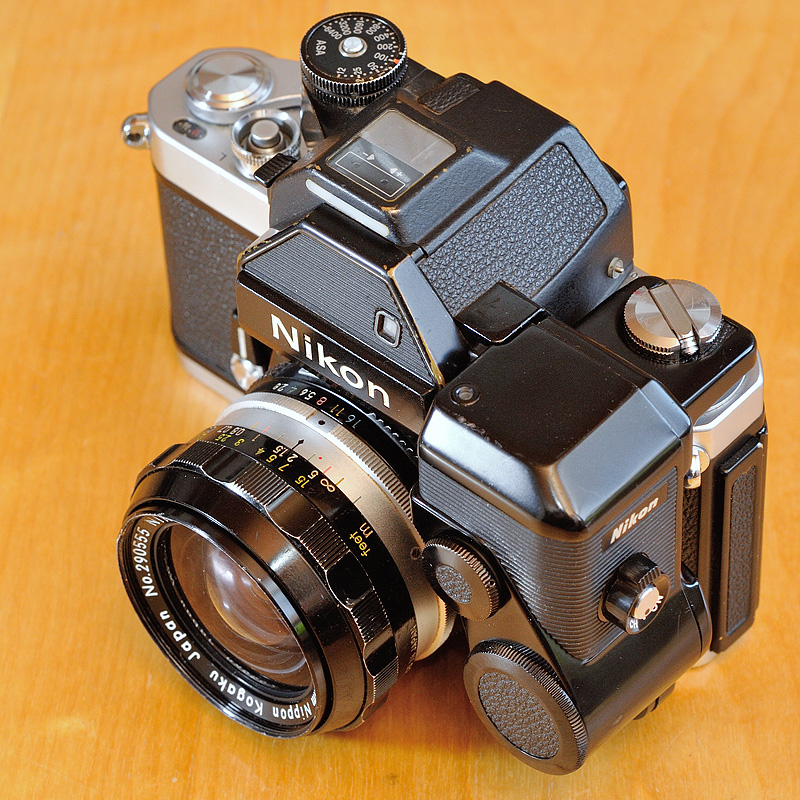
|
|
The automated F2 Nikon F2S with DS-1 |
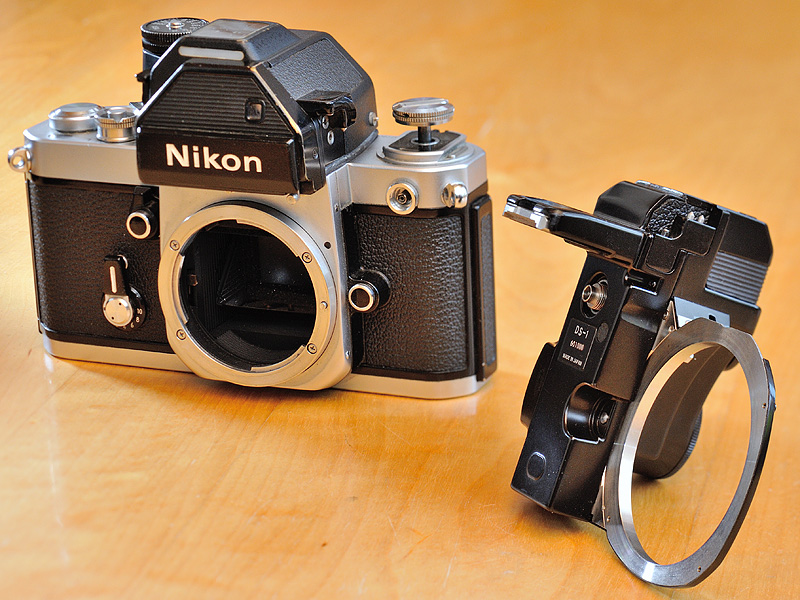
|
The aperture control attachment works completely different from the shutter priority mode in your modern Nikon SLR or DSLR. This solution from the 70s really moves the lens' aperture ring physically until the photomic finder signals correct exposure. Moreover it is a bit slow - it takes about 2-3 seconds to pass through the complete aperture range. Nevertheless it works and it is an impressive piece of technology!
The DS-1 is mounted via the screw mount within the flash terminal. Flashing is not possible when the DS-1 is mounted. The later DS-2 is identical, except for a flash terminal. No big deal, especially because it makes not much sense to flash while the DS-1 is operating. The last photomic finder for the F2 before the introduction of the AI system was the DP-3. This finder works with the DS-1 or DS-2, too.
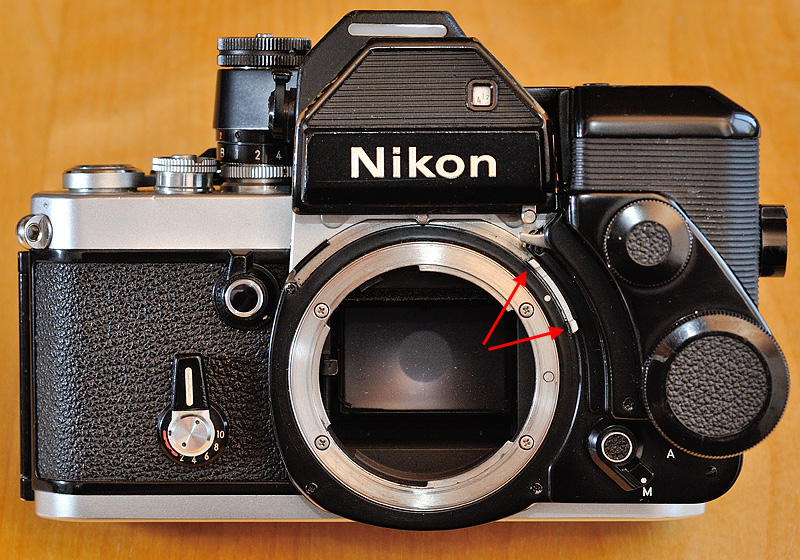
|
|
The DS-1 or DP-2 has a catch (see red arrows in the image above) that encloses the lens' coupling shoe. Before mounting the lens this catch must be moved to the rightmost position and the lens must be set to F5.6. Of course, the forth and back rotation of the aperture ring - as described in the previous chapter - is additionally necessary for the proper coupling of the DP-2 or DP-3. |
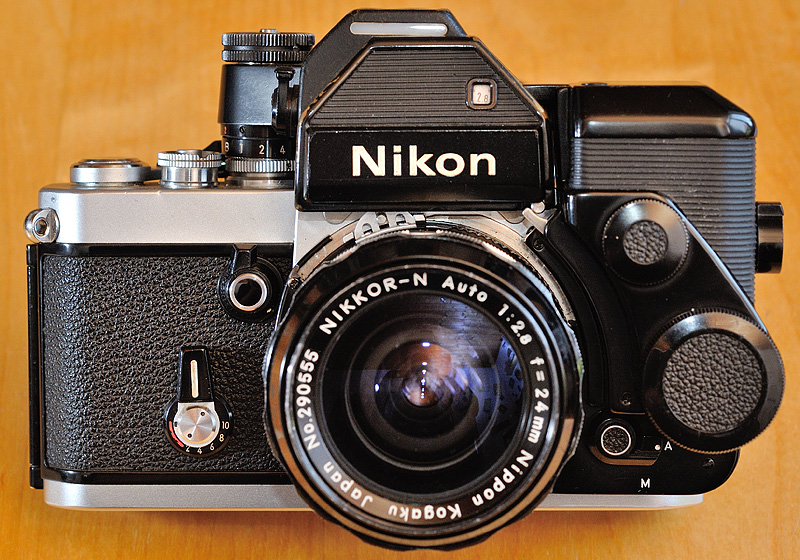
|
In 1977 Nikon introduced the AI system that made the coupling shoes obsolete. AI stands for Automatic Indexing. Via the AI coupling the camera reads the relative aperture (e.g. stopped down for two stops) from the lens. That simplified the interface significantly! On the other hand, Nikon now had the opposite problem: the DP-1, DP-2 and DP-3 Photomic finders display both the shutter speed and the aperture value in the finder. The new AI lenses have a lens speed index post that would allow mechanical indexing for displaying the aperture. But Nikon provided a second and easier possibility: ADR - Aperture Direct Readout. That is an additional aperture scale on the AI aperture ring with smaller digits for direct projection into the finder.
More information about the AI coupling can be found in these articles: Using older lenses on your Nikon DSLR and The difference between an AI-modified and an AI lens.
The Photomic finders of the F2 were replaced with AI equivalents: the DP-1 with the DP-11 (with a needle) and the DP-3 with the DP-12 (with LEDs). An F2 with a DP-11 is called an F2A and with a DP-12 is an F2AS. The aperture control unit DS-2 was replaced with the DS-12.
The F was discontinued in 1974. Although it would have been technically possible, Nikon did not offer an AI Photomic finder for the F as part of the AI changeover.
The two Nikkormats in Nikon's lineup of that time were replaced with AI versions: the Nikkormat FT2 with the Nikkormat FT3 and the Nikkormat ELW with the Nikon EL2.
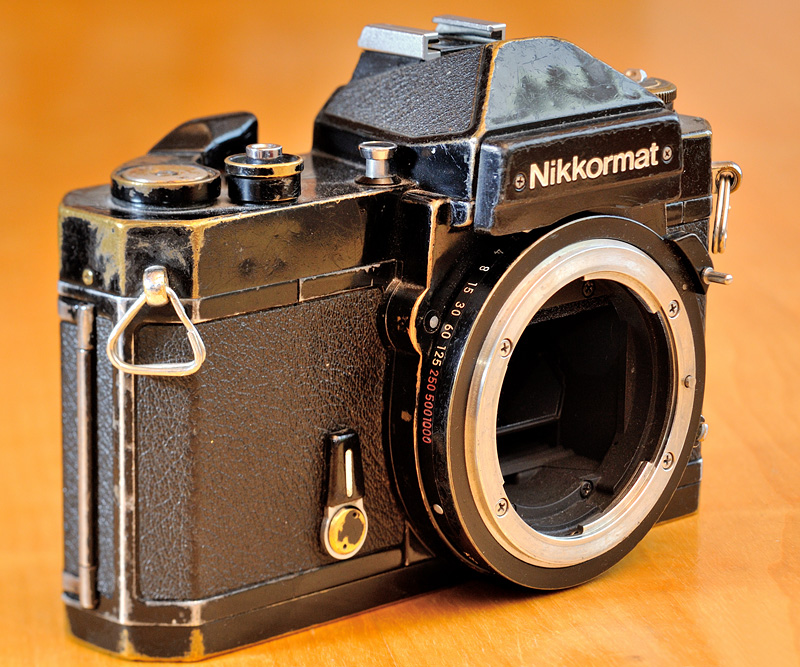
|
|
Nikon camera bodies are built for heavy usage. I paid only 25 euros for this Nikkormat FT2 twelve years ago. Despite its condition everything works fine, even today! The only problem is - not joking - that my fingers smell strongly of metal after a couple of shots. |
Although the prices for used analogue cameras have decreased significantly over the last years, the Nikon F and F2 are still more expensive samples.
The Nikkormat EL is a nice and for its time a very modern camera - the FE, FE2 and FM3a inherited the EL design. But in my opinion in terms of design the EL is the least exotic body of the coupling shoe era. Moreover, due to its electronic shutter you don't hear the typical humming sound when longer shutter speeds are used.
For a first step into Nikon's history I recommend to buy a Nikkormat FT2. You will find used FT2 cameras at reasonable prices, especially if you do not look for like-new samples. While the FT2 looks very similar to the previous models FT and FTn, it has an important advantage for using it today: it is powered by a cheap and easy-to-find LR44 battery...
BTW: if you need detailed information about how to use a particular camera body, search the Web for a PDF manual. Have a look at my "links" section under "Nikon History", too.
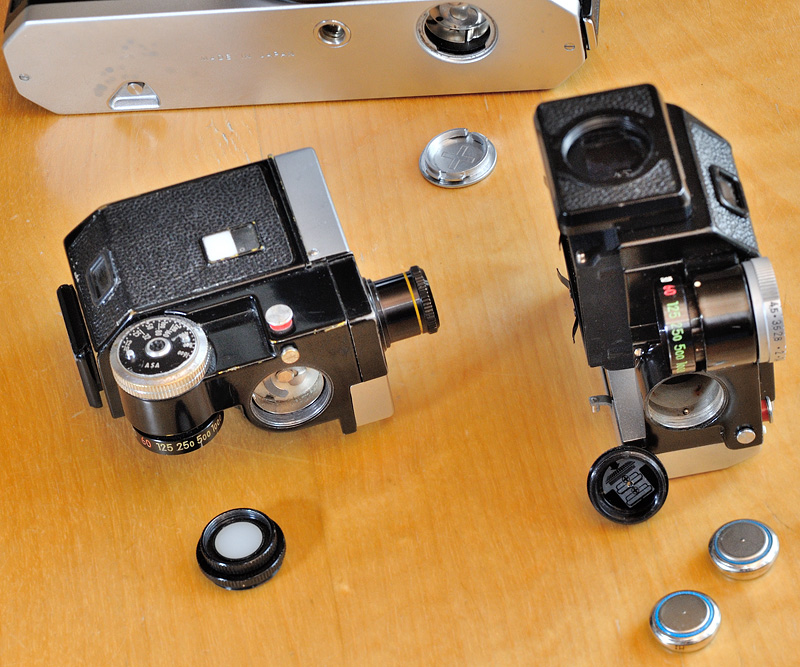
|
|
The 1.35 V Mercury cell is the battery of Nikon's first SLR generation. |
|
|
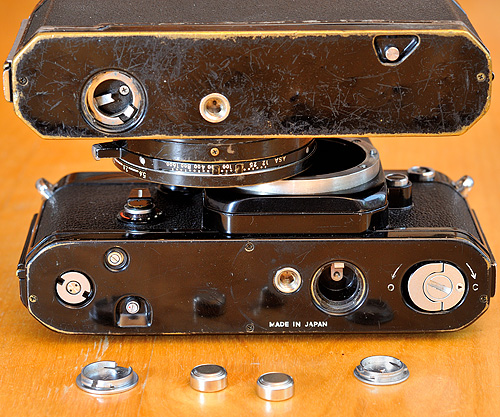
|
|
Nikon F2 and Nikkormat FT2 were the first Nikon cameras which need LR44 type batteries (the last one was the FM3a from 2001). |
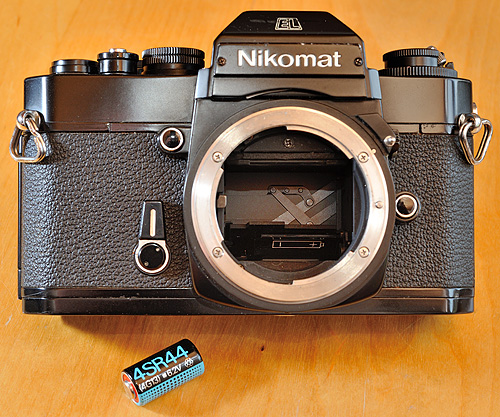
|
|
Among the Nikon SLRs the 4SR44 type battery was only employed for the Nikkormat/Nikon EL series. |
Mechanically the early Nikon bodies are very sturdy. That is not just a legend, it is reality! And even the electronics of these cameras - if present - is of high quality. But for the electronics - except for the mountable meters - you need batteries.
The Photomic finders for the Nikon F and the Nikkormat FT and FTn bodies need a typical battery of that time: a 1.35 V Mercury battery (PX625). The modern version of this battery (PX625A) fits, but has a higher voltage (1.5 V) which leads to a non-correct metering. An alternative is the 1.35 V Wein Cell MRB625. This battery works fine, but it is expensive and has only a low capacity.
One of the improvements of the Nikon F2 over the F is that the power supply of the Photomic finders is located in the bottom of the camera body. Moreover the F2 needs two LR44 batteries (just like e.g. F3 series, FM series, FE series), which is an cheap and easy-to-find type. The 1975 introduced Nikkormat FT2 needs one LR44.
The Nikkormat EL and ELW (and the Nikon EL2 as well) works with a 6 V 4SR44 battery. This relatively cheap battery is overall easy-to-find. The position of the battery compartment is a bit unusual: it is located in the bottom of the mirror chamber and before you can access the battery you must lock up the mirror!
Good news about the motor drives: standard size batteries can be put into service here. Some older battery compartments for the F-36 motor drive need 'C' batteries, otherwise 'AA' batteries can be used for Nikon's early motor drives and for the AW-1 winder for the Nikkormat ELW. But please note: in the early years the electric circuits of the camera and the motor drive were independent from each other, thus you need batteries for both!
A real problem is the power supply of the DS-1 and DS-2 aperture control attachments (and DS-12 as well)! The rechargeable DN-1 battery was included in delivery. For charging a rare DH-1 is needed. Most of the DN-1 are (nearly) dead today. But some repair shops offer replacements for a DN-1 (search on ebay.com for Nikon DN-1). Alternative power supplies for the DS attachments are the DB-1 battery pack and the MA-4 AC/DC converter. But these accessories are very rare and moreover you need the proper cables!